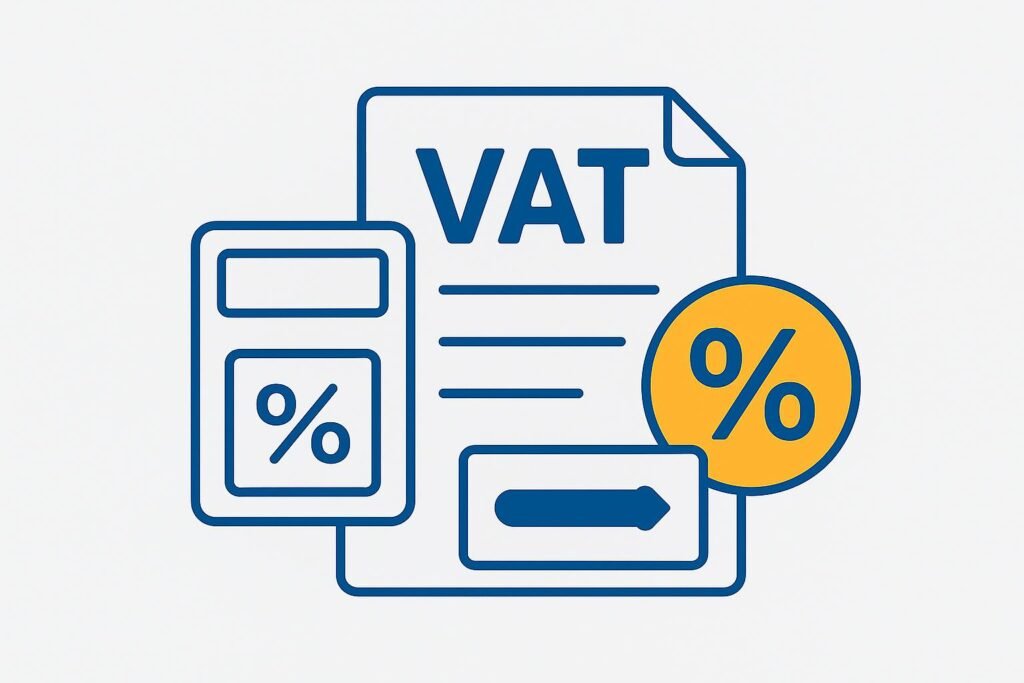
VAT is something that many new business owners overlook. Many assume that it doesn’t apply to them – surely it’s just for the bigger businesses out there? That may be true most of the time, but VAT could still apply to your business, so it’s important to know about it.
If you’re a sole trader looking to get clued-in about all things VAT, keep reading. We’ll take you through whether you need to register, how to register, and what you need to do next.
What is VAT?
VAT (Value Added Tax) is a tax levied on the sale of goods and services in the UK. Businesses that are VAT-registered must charge their customers VAT on the products or services they sell and then pay this tax to HMRC, usually on a quarterly basis.
How does VAT work?
VAT works in two directions for business owners – you charge VAT and you pay VAT.
VAT-registered businesses charge their customers VAT on sales. They also pay VAT when they buy goods or services for their business. The difference between what you’ve charged and what you’ve paid is either paid to HMRC or reclaimed.
For example, if you paid £500 in VAT to suppliers, but charged £800 in VAT to customers, you owe HMRC £300. But if the reverse is true, HMRC will refund you the difference.
Do I need to register for VAT?
Any business with a turnover of £90,000 or more over the last 12 months must register for VAT (from April 2025). This applies regardless of your business structure. If you’re a sole trader and hit this threshold, you must register and start charging VAT.
Should you voluntarily register for VAT?
You can register for VAT before hitting the threshold. This is known as voluntary registration, and it might benefit you depending on how your business operates.
1. You can reclaim VAT
If most of your suppliers are VAT-registered, you may be able to reclaim VAT on significant purchases. This can help reduce your costs.
2. It can make your business look more established
Being VAT-registered can add credibility, particularly if you’re dealing with larger companies. It gives the impression of scale and permanence – even if you’re a one-person business.
However, if your customers are mainly the general public (who can’t reclaim VAT themselves), you’ll need to weigh up whether charging VAT will make your prices less competitive.
How do I register for VAT?
Most sole traders can register online via HMRC’s VAT registration portal. You’ll need to provide details like:
- Your National Insurance number
- Your Unique Taxpayer Reference (UTR)
- Your expected turnover
- Your business contact and bank details
If you have an accountant, they can register and submit returns on your behalf.
What happens after you register for VAT?
You’ll receive a VAT registration certificate within 30 working days. This contains your VAT number, your “effective date of registration,” and your first return deadline.
Make a note of these dates – late filings can result in penalties. You must begin charging VAT from the effective date.
Charging and reclaiming VAT
As a VAT-registered sole trader, you must:
- Determine the correct VAT rate for your products or services
- Charge the correct VAT on invoices
- Include your VAT number on each invoice
- Maintain accurate records of VAT charged and paid
- Submit quarterly VAT returns
You can reclaim VAT on most business-related purchases, as long as you have a valid VAT invoice.
What makes a VAT invoice valid?
To reclaim VAT, the invoice must include:
- The supplier’s VAT number
- The total cost and VAT charged
- Date of issue
- Description of goods or services
- Supplier’s name and address
You can check the validity of any VAT number using HMRC’s VAT number checker.
Current VAT rates
There are three main VAT rates in the UK:
- Standard Rate (20%): Applies to most goods and services.
- Reduced Rate (5%): Applies to things like domestic energy and children’s car seats.
- Zero Rate (0%): Applies to goods like most food items, books and children’s clothing.
You must ensure you apply the correct rate when invoicing your customers.
How to submit VAT returns
You’ll usually need to submit a VAT return every quarter. This shows the amount of VAT you’ve charged and the amount you’ve paid out.
VAT returns must be submitted digitally through HMRC-compatible software under the Making Tax Digital (MTD) rules.
Deadlines are one month and seven days after the end of the VAT period. For example, if your quarter ends on 31 March, you must file by 7 May.
Most accounting software (like Xero or FreeAgent) includes MTD support and makes it easy to prepare and submit returns on time.
Extra tips for sole traders
- Set aside the VAT you collect – don’t treat it as income.
- Keep digital copies of all invoices and receipts.
- Consider the Flat Rate VAT Scheme if you have low expenses – it can simplify things.
- Review whether VAT registration still suits your business annually, especially if your turnover fluctuates.
- Speak to an accountant if you’re unsure about anything VAT-related – mistakes can be costly.
For more detailed guidance, visit HMRC’s VAT section.



